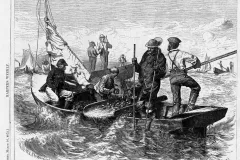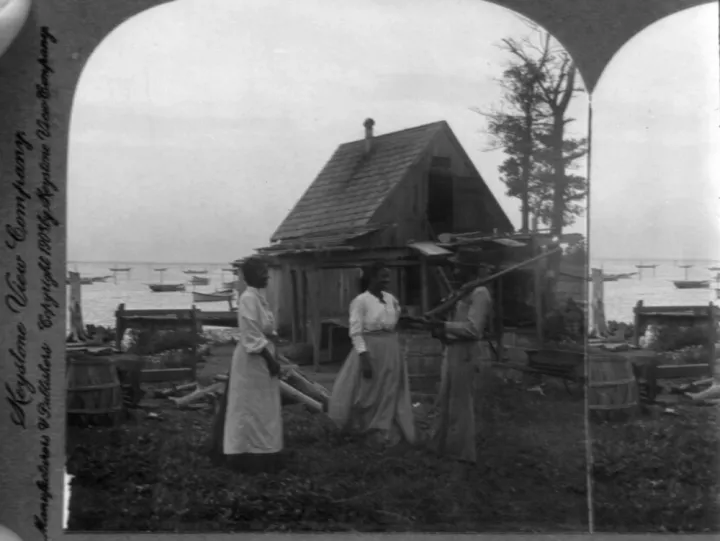The Bay of Opportunity and Hope

The waters of the Chesapeake Bay hold a special place for Black Americans. The complex network of the bay’s inlets and waterways that are home to shellfish, fish, and wetlands enabled Black Americans freedoms from the time of the first Africans brought to the Americas as slaves and servants, through the Civil War and created a legacy that still lingers today.
This legacy between Blacks and the Chesapeake began early on in American history. The first enslaved Africans to arrive in what is now the United States were brought to Virginia settlements like Jamestown through Point Comfort in 1619 via the Chesapeake’s waterways. From the very beginning, the lives of many enslaved Africans were tied to the Chesapeake Bay and its tributaries—for many it was the first glimpse of the Americas.
By the mid 1600s the majority of enslaved Africans in the Chesapeake region worked on tobacco plantations. Initially slavery was not a binding life sentence, but a sentence similar to indentured servitude that could be ended through years of labor. Though most enslaved Africans remained enslaved for their entire life, freedom was an attainable goal. On Maryland’s Eastern Shore on the Northampton peninsula a community of 13 African families paid for their freedom and built a thriving economy selling cattle and tobacco on leased land. No roads existed to Northampton so taking a boat via the Chesapeake’s tributaries was the only means of travel. The remoteness of the Eastern Shore likely helped the community thrive without the oversight of English society.
In the early 1800s seafaring jobs were some of the few careers that employed freed Blacks. An expansion of the shipping industry following the Revolutionary War created ample job opportunities, but the low wages and lack of independence deterred white people and left a void to be filled by Black workers. For newly freed slaves, however, the steady income and worldly work was an opportunity for a better life.
By 1803 about 18 percent of America’s seafaring jobs were freed Blacks. Black workers filled every type of job in the industry. Some climbed the ranks and became ship captains, others successful business owners. Nearly every ship caulker in the famed Fells Point shipyard in Baltimore was Black, and they earned one of the highest paid wages for a skilled worker in the shipyard. Free Black seamen were so commonplace that Frederick Douglass, a young Maryland native, escaped to freedom by donning the striped uniform of a seamen as he traveled north.
Ship life enabled enslaved Blacks to experience independence and worldliness unavailable on plantations. But shipping also had its limitations just like anywhere else in the country. Enslaved Blacks were able to rise to command or pilot a ship, but freed Blacks were kept from commanding their own vessels. Captain George Henry captained cargo schooners throughout the bay and was a renowned and skilled captain. Upon freedom, however, he was forced to take a job as a ship’s cook.
As a massive harbor with ports like Baltimore, the Chesapeake is a bay of industry, but it is also a refuge for wildlife. The sprawling creeks and inlets that feed the massive bay are home to countless crabs, shellfish, and fish. It is in these marshy wetlands of rural Virginia and Maryland that Black oystermen capitalized on the marine bounty for their own success.
Following the collapse of the tobacco industry due to negligent farming practices and depleted soil, some plantation owners sent enslaved people to work on fishing boats. Often these individuals became the most skilled in the trade, and their hard work was rewarded. At the end of the Civil War, many Black fishermen owned their own boats, finding that at sea there was a level of equality among all fishermen, black and white, not found on shore. At least one out of ten fishing boats had a Black captain following the Civil War.
Oysters have historically been one of the most important fisheries in the region. By 1860 the Chesapeake Bay supplied the nation with the majority of its oysters—oysters were known as white gold. At the backbone of the industry were Black oystermen. Newly freed, Black watermen moved to the unclaimed land of the bay, the mosquito infested lowlands. Up until the mid 1900s harvesting oysters was only allowed in the county where a fisherman lived, and so Blacks living in the lowlands had prime access to some of the best fishing in the bay. They also came armed with knowledge passed down through the generations. Black fishermen could make a decent income for his family—the industry was one of the highest paid jobs for a Black man in the Chesapeake.
The Chesapeake offered many opportunities for Black entrepreneurs. However, they were continually confronted by racism—oystermen recount how the fishing plants left Black oystermen to sell last, often declining their catch due to “ice shortages” which led to harvests being dumped back in the bay.
However, by the late 1800s many Black businesses began to establish themselves and thrived. Several Black owned seafood processing facilities emerged in the early 1900s including the Coulbourne and Jewett Packing Company in St. Michaels and the Bellevue Seafood Company operated by the Turner family, both in Maryland. In Bellevue, the Turner family built the largest seafood plant in the town. Through the mid-1900s they would operate two separate facilities and processed crabmeat, oysters, and clams. Other notable businesses include Captain George Brown’s Steamboat Ferries that brought middle class Black Baltimoreans from the city to Brown’s Grove beaches on the bayside and Curtis Downes’ sail-making business on Oxford, Maryland that serviced many prominent families, including the Kennedys.
Today, mirroring general industry trends, the number of Black captains and industries in the Chesapeake Bay are in decline. In 1880 at the height of the oyster industry, the total oyster harvest reached around 6 million bushels. Today that number is less than 100 thousand bushels annually. Many multi-generational watermen have left the industry due to declines in the oyster population due to disease, natural disasters, a bust in the cycle of crabs, unpredictable markets, and environmental changes.
However, a small group of advocates that include captains, historians, and oystermen hope to preserve the legacy and inspire the next generation to take up the reins on the waterways. The organization Blacks of the Chesapeake began shedding light on the legacy of Blacks in the bay starting in the 1980s, and today they continue this mission through community building and outreach. Partnering with Blacks in Marine Science, they are working with Black communities on the bay to better understand the local ecology, all with the aim of preserving the waterman heritage for future generations.
Perhaps, like in centuries past, a little perseverance and a strong work ethic will help revitalize the vanishing Black watermen. There is much to overcome in the industry—economic costs and a diminished fishery, but many people are determined to keep this legacy from becoming a thing of the past. Regardless, the history and impact of Black watermen from the time of slavery to today shows that the Blacks of the Chesapeake shaped a nation and carved out a livelihood that brought about a little bit of dignity and independence in an unfair world.
____________________________
Editor’s Note: This article was reviewed with the help of Vincent Leggett, Admiral of the Chesapeake


